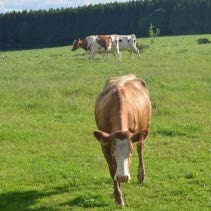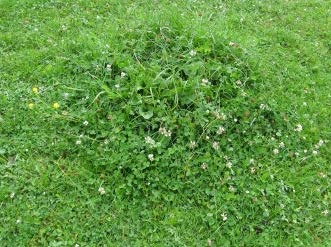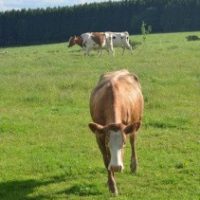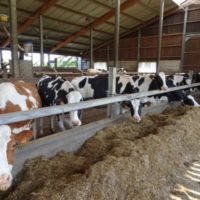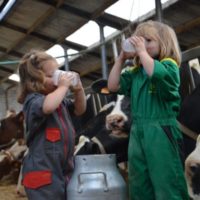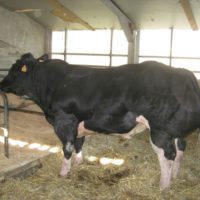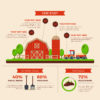Description
Background
The farm is located in Manderfeld, a section of the town of Büllingen in the Eastern part of Belgium.
The father “René” took over from his father in 1979. The same year he build a new stable for the milking cows. In 1998-2000, he transited to a 100% organic milk production. In 2009, his two daughters integrated the farm. The same year, they started to interest themselves to short-grass grazing. In 2010, they build new stables to enlarge the farm and they acquired an additional 50ha.
In 2009, the farm was composed of a total of 53ha and 50 red-Hostein milkin cows.
Today, the farm has about 100 dairy cows. It includes mainly Brown-Swiss, Jersey and Montbéliard breeds. However, since the farm was originally a red and black Holstein farm, there are still some Holstein crossbreed in the herd. They are operating on 112 ha of grassland, of which 30 ha are from high biological value. 40 ha are in direct proximity of the farm and thus, provide the necessary surface for a pasture based production.
The constant reflection of the farmers to become more productive, to lower costs and to better the quality of the end-product led them to turn towards the short grass-grazing pasture management system.
Detailed description
It’s been 9 years that the farm practices short grass grazing, a technique which aims to keep the grass short (about 6-7 cm high) throughout the growing season. The size of the available grazing surface is continuously adjusted so that the daily consumption of the cows equals the growth of the grass in the meadow.
Usually the cattle are released in the meadow for the first time mid-March. At this period of time in the year the cattle still get a complementation of fodder in the stable, but it’s very important to keep the grass very short from the beginning of the season. Then, from mid-April to mid-May, 25 to 30 acres per cow are sufficient, without additional complementation in the stables. From the beginning of May, the growth speed of the grass reaches its peak. The pasture is then mown, removing a certain proportion of the surface. After mowing, additional surface is made available for pasture to compensate for the slower growth rate of the grass in the summer. The 40 hectares of pasture are divided into two plots, one for the day and one for the night. This is so for the convenience of the farmer.
The grass adapts itself to the pasture conditions. The grass becomes denser, and leaves little room for the development of weeds. Rumex, for example, can not bear to be grazed repeatedly and dies out. On the other hand, these conditions ensure the growth of English rye grass and white clover which benefits from additional light and enriches the pasture with nitrogen.
Thus, short grass grazing provides very digestible protein-rich grass. The low height of the grass imposes intensive grazing, increasing the salivation, which prevents acidosis problems.
To optimize even further the use of the pasture, the Theissen family chose to organize the calving of seasonally. The cows calve between January and the end of April, thus enabling the cows to have the best grass at the peak of their lactation.
All the organic milk of the Theissen farm is sold to the dairy factory Arla.
Results
The average organic dairy yield of the Theissen farm is around 5,400 liters (2017) of milk per cow and per lactation. Theissen’s dairy cows receive only 350 kg of concentrates per cow per year, just enough to encourage them to return at the stable for milking. As a comparison, organic milk farms in the area produce on average less then 6000 liters of milk with 900 kg of concentrates and conventional farms produce on average 7,000 liters of milk with 1,800 kg of concentrates per cow. The average lifetime of the cows on the farm is 6,5 years and they have in general an average of 4 calves before they leave the farm.
For the farmers, this grazing management system enables them: more autonomy, more efficiency, to reduce costs, to work less, to create a better quality of milk and to get a better revenue.
Adoption criteria
First, the most important condition for short grass grazing is to have enough available grazing surfaces around the farm. It should be possible to make 2 big plots with at least 0.15 ha per cow each. There is not really a need for over sawing the pasture. The vegetation adapts itself to this grazing type. There is not much to do besides adjusting the size of the pasture to the growth rate of the grass.
The breeding of the herd towards a more adapted breed to grazing as well as the seasonal calving are both options that enhance even more the productivity of the grassland. If the technique of continuous short grass grazing is not applicable to all farms, it can nevertheless lead to a reflection on the optimal valorization of the grass, which is an ideal food in terms of nutritional quality and economy for the farm.
Future prospects
The future prospects of the Theissen dairy farm are bright.
However, for the future prospects of the short-grass grazing pasture management as a whole, one thing they would hope for is to see more independent scientific studies to be made on the topic.
There are already many studies around the subject. Unfortunately, most of these are conducted by enterprises that have a commercial goal. Therefore, the result of these studies are not unbiased.

